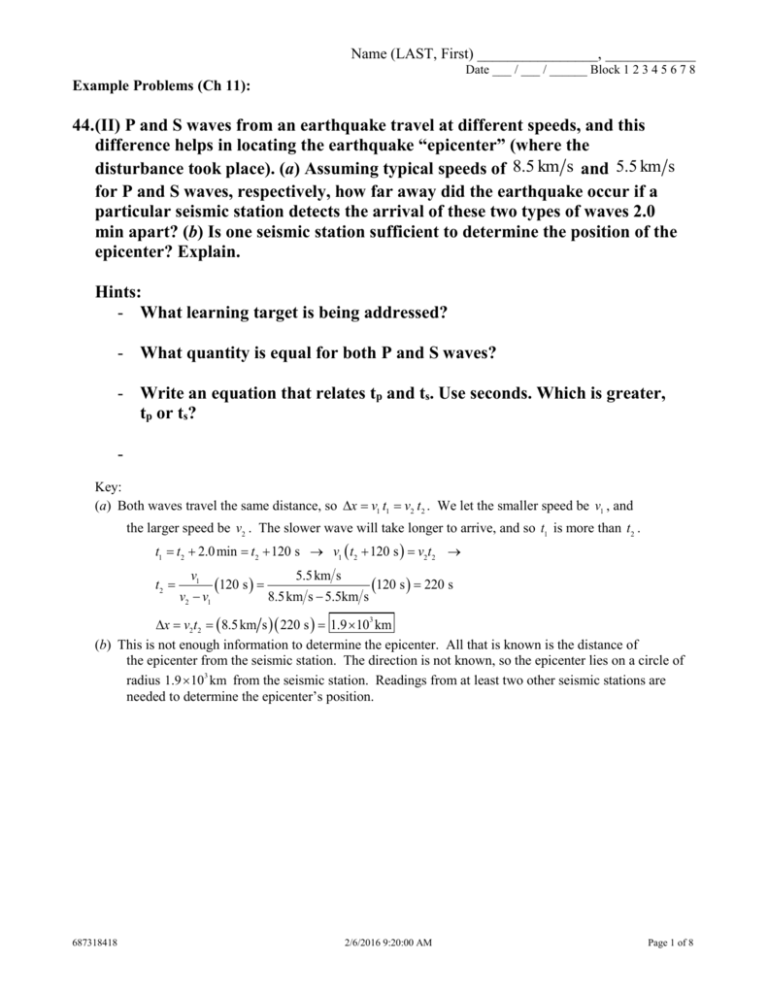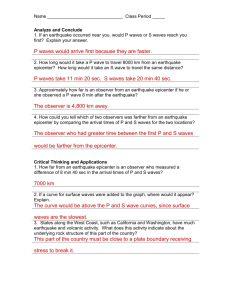Example Problems (Ch 11 and Ch 12)
advertisement

Name (LAST, First) ________________, ____________ Date ___ / ___ / ______ Block 1 2 3 4 5 6 7 8 Example Problems (Ch 11): 44.(II) P and S waves from an earthquake travel at different speeds, and this difference helps in locating the earthquake “epicenter” (where the disturbance took place). (a) Assuming typical speeds of 8.5 km s and 5.5 km s for P and S waves, respectively, how far away did the earthquake occur if a particular seismic station detects the arrival of these two types of waves 2.0 min apart? (b) Is one seismic station sufficient to determine the position of the epicenter? Explain. Hints: - What learning target is being addressed? - What quantity is equal for both P and S waves? - Write an equation that relates tp and ts. Use seconds. Which is greater, tp or ts? Key: (a) Both waves travel the same distance, so x v1 t1 v2 t2 . We let the smaller speed be v1 , and the larger speed be v2 . The slower wave will take longer to arrive, and so t1 is more than t2 . t1 t2 2.0 min t2 120 s v1 t2 120 s v2t2 t2 v1 v2 v1 120 s 5.5 km s 8.5 km s 5.5km s 120 s 220 s x v2t2 8.5 km s 220 s 1.9 103 km (b) This is not enough information to determine the epicenter. All that is known is the distance of the epicenter from the seismic station. The direction is not known, so the epicenter lies on a circle of radius 1.9 103 km from the seismic station. Readings from at least two other seismic stations are needed to determine the epicenter’s position. 687318418 2/6/2016 9:20:00 AM Page 1 of 8 Name (LAST, First) ________________, ____________ Date ___ / ___ / ______ Block 1 2 3 4 5 6 7 8 45. (III) An earthquake-produced surface wave can be approximated by a sinusoidal transverse wave. Assuming a frequency of 0.50 Hz (typical of earthquakes, which actually include a mixture of frequencies), what amplitude is needed so that objects begin to leave contact with the ground? [Hint: Set the acceleration a g. ] Hints: - What learning target is being addressed? - Find an equation that relates acceleration to amplitude and frequency. - You may have to combine two or more equations. So, first find an equation that relates a to either A or f. - Key: We assume that the earthquake wave is moving the ground vertically, since it is a transverse wave. An object sitting on the ground will then be moving with SHM, due to the two forces on it – the normal force upwards from the ground and the weight downwards due to gravity. If the object loses contact with the ground, then the normal force will be zero, and the only force on the object will be its weight. If the only force is the weight, then the object will have an acceleration of g downwards. Thus the limiting condition for beginning to lose contact with the ground is when the maximum acceleration caused by the wave is greater than g. Any larger downward acceleration and the ground would “fall” quicker than the object. The maximum acceleration is related to the amplitude and the frequency as follows. g g 9.8 m s 2 amax 2 A g A 2 2 2 2 0.99 m 2 4 f 4 0.50 Hz 687318418 2/6/2016 9:20:00 AM Page 2 of 8 Name (LAST, First) ________________, ____________ Date ___ / ___ / ______ Block 1 2 3 4 5 6 7 8 46.(II) What is the ratio of (a) the intensities, and (b) the amplitudes, of an earthquake P wave passing through the Earth and detected at two points 10 km and 20 km from the source? Hints: - What learning target is being addressed? - What letter is used to represent intensity? - Find (and use) an equation that relates intensity to distance. - Find (and use) an equation that relates amplitude to distance. Key: (a) Assume that the earthquake waves spread out spherically from the source. Under those conditions, Eq. (11-16b) applies, stating that intensity is inversely proportional to the square of the distance from the source of the wave. I 20 km I10 km 10 km 20 km 0.25 (b) The intensity is proportional to the square of the amplitude, and so the amplitude is inversely proportional to the distance from the source of the wave. A20 km A10 km 10 km 20 km 0.50 2 687318418 2 2/6/2016 9:20:00 AM Page 3 of 8 Name (LAST, First) ________________, ____________ Date ___ / ___ / ______ Block 1 2 3 4 5 6 7 8 47.(I) Two earthquake waves of the same frequency travel through the same portion of the Earth, but one is carrying twice the energy. What is the ratio of the amplitudes of the two waves? Hints: - What learning target is being addressed? - Find an equation that relates energy and amplitude. (In all likelihood this equation will also contain frequency. How do I know that?) Key: From Equation (11-18), if the speed, medium density, and frequency of the two waves are the same, then the intensity is proportional to the square of the amplitude. I 2 I1 E2 E1 A22 A12 2 A2 A1 2 1.41 The more energetic wave has the larger amplitude. 687318418 2/6/2016 9:20:00 AM Page 4 of 8 Name (LAST, First) ________________, ____________ Date ___ / ___ / ______ Block 1 2 3 4 5 6 7 8 55. (II) The velocity of waves on a string is 92 m s . If the frequency of standing waves is 475 Hz, how far apart are two adjacent nodes? Hints: - What learning target is being addressed? - Draw a picture representing a standing wave on a string? - Is the string “open” or “closed” at each end? Does it matter? What is meant by open and closed WRT a string? Key: Adjacent nodes are separated by a half-wavelength, as examination of Figure 11-40 will show. v v 92 m s xnode 12 9.7 10 2 m f 2 f 2 475 Hz 687318418 2/6/2016 9:20:00 AM Page 5 of 8 Name (LAST, First) ________________, ____________ Date ___ / ___ / ______ Block 1 2 3 4 5 6 7 8 56. (II) If two successive overtones of a vibrating string are 280 Hz and 350 Hz, what is the frequency of the fundamental? Hints: - What learning target is being addressed? - Go back to the closed tube resonator data you collected in class. - Successive overtones of a string are what part (multiple or fraction) of a wavelength different? - Are the overtones of a string harmonics? (How do overtones and harmonics differ?) (Define both overtone and harmonic) Key: Since f n nf1 , two successive overtones differ by the fundamental frequency, as shown below. f f n1 f n n 1 f1 nf1 f1 350 Hz 280 Hz 70 Hz 687318418 2/6/2016 9:20:00 AM Page 6 of 8 Name (LAST, First) ________________, ____________ Date ___ / ___ / ______ Block 1 2 3 4 5 6 7 8 Example Problems (Ch 12): 53.(II) A bat at rest sends out ultrasonic sound waves at 50.0 kHz and receives them returned from an object moving directly away from it at 25.0 m s . What is the received sound frequency? Hints: - What learning target is being addressed? - Which is moving, the source or the observer? - What is the source? What is the observer? - Find an equation that relates frequency and speed of what is moving (source or observer). Key: The moving object can be treated as a moving “observer” for calculating the frequency it receives and reflects. The bat (the source) is stationary. v f bat 1 object f object vsnd , and the bat as a stationary Then the object can be treated as a moving source emitting the frequency f object observer. f bat f object vobject 1 v snd vobject 1 v snd f bat vobject 1 v snd 5.00 10 4 Hz 687318418 f vsnd vobject bat vsnd vobject 343 m s 25.0 m s 343 m s 25.0 m s 4.32 10 4 Hz 2/6/2016 9:20:00 AM Page 7 of 8 Name (LAST, First) ________________, ____________ Date ___ / ___ / ______ Block 1 2 3 4 5 6 7 8 58.(III) A factory whistle emits sound of frequency 570 Hz. When the wind velocity is 12 .0 m s from the north, what frequency will observers hear who are located, at rest, (a) due north, (b) due south, (c) due east, and (d) due west, of the whistle? What frequency is heard by a cyclist heading (e) north or (f) west, toward the whistle at 15.0 m s ? Assume T 20 º C. Hints: - What learning target is being addressed? - Sketch the problem, showing wind direction. (There is more than one problem!) - Is the wind the source or the observer? Key: The Doppler effect occurs only when there is relative motion of the source and the observer along the line connecting them. In the first four parts of this problem, the whistle and the observer are not moving relative to each other and so there is no Doppler shift. The wind speed increases (or decreases) the velocity of the waves in the direction of the wind, and the wavelength of the waves by the same factor, while the frequency is unchanged. f f 570 Hz (a), (b), (c), (d) (e) The wind makes an effective speed of sound in air of 343 + 12.0 = 355 m/s, and the observer is moving towards a stationary source with a speed of 15.0 m/s. v 15.0 m s f f 1 obs 570 Hz 1 594 Hz 355 m s vsns (f) Since the wind is not changing the speed of the sound waves moving towards the cyclist, the speed of sound is 343 m/s. The observer is moving towards a stationary source with a speed of 15.0 m/s. v 15.0 m s f f 1 obs 570 Hz 1 595 Hz 343 m s vsns 687318418 2/6/2016 9:20:00 AM Page 8 of 8






